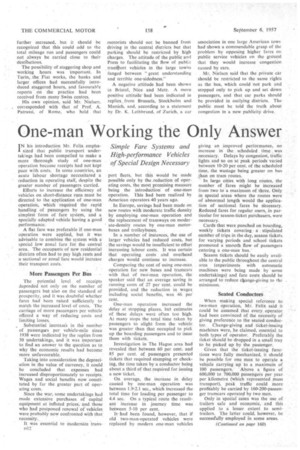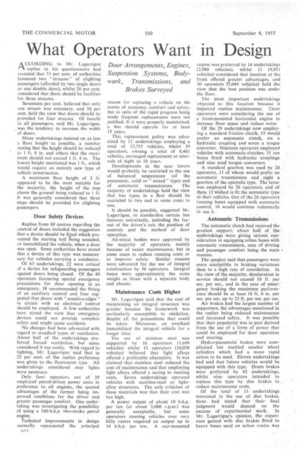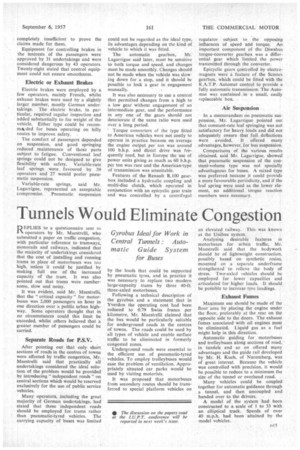One-man Working the Only Answer
Page 58

Page 60

Page 61

If you've noticed an error in this article please click here to report it so we can fix it.
IN his introduction Mr. Felix empha sized that public transport undertakings had been compelled to make a more thorough study of one-man operation because receipts had not kept pace with costs. in some countries, an acute labour shortage necessitated a reduction in operating staff, despite the greater number of passengers carried.
Efforts to increase the efficiency of vehicles on short-distance runs must be directed to the application of one-man operation, which required the rapid handling of passengers by using the simplest form of fare system, and a specially adapted vehicle having a good performance.
A flat fare was preferable if one-man operation were applied, but it was advisable to combine the system with a special low zonal fare. for the central area. The occupants of new residential districts often had to pay high rents and a-sectional or zonal fare would increase their transport costs.
More Passengers Per Bus
The potential level of receipts depended not only on the number of passengers but also on the standard of prosperity, and it was doubtful whether fares had been raised sufficiently to match the increased level of costs. The carriage of more passengers per vehicle offered a way of reducing costs and limiting losses.
Substantial increases in the number' of passengars per vehicle-mile since 1938 were indicated by the replies from 30 undertakings, and it was important to find an answer to the question as to why the economic results had become more unfavourable.
Taking into consideration ther.depreciation in the value of currency, it could be concluded that, expenses had increased disproportionately to receipts. Wages and social benefits now constituted by far the greater part of operating costs.
Since the war, some undertakings had made extensive purchases of capital equipment at inflated prices, and those who had postponed renewal of vehicles were .probably now confronted with that necessity.'
It Was essential to modernize transD12 port fleets, but thiS would be made possible only by the .reduction of operating costs, the most promising measure being the introduction of one-man operation. This had been realized by American operators 40 years ago.
In Europe, savings had been made on new routes with Moderate traffic density by employing one-man operation and the replacement of tramways on moderate-density routes by one-man motorbuses and trolley buses.
In a number of instances, the use of larger vehicles had reduced costs, but the savings would be insufficient to offset increasing labour costs. It was certain that operating costs ahd overhead charges would continue to increase.
Comparing the cost of using one-man operation for new buses and tramcars with that of two-man operation, the speaker said that an average saving in running costs of 27 per cent, could be provided, and the reduction in wages including social benefits, was 46 per cent.
One-man operation increased the delay at stopping places, but estimates of these delays were often too high. At many stops the total' time taken by passengers to alight from the vehicle, was greater than that occupied to pick up the boarding passengers and to issue them with tickets.
Investigation in The Hague area had revealed that between 60 per cent. and 85 per cent, of passengers presented tickets that required stamping or checking, the time taken by a conductor. being about a third of that required for issuing a new ticket.
On average, the increase in delay caused by one-man operation was between 1.9-2.1 sec., which increased the total time for loading per passenger to 4.4 sec. On a typical route the resultant increase in journey time was between 5-10 per cent.
It-had been found, however, that if old two-man-operated vehicles were replaced by modern one-man vehicles
giving an improved performance, no increase in the scheduled time was necessary. Delays by congestion, traffic lights ,and-so on 'at peak periods varied between 10-20 per cent, of the scheduled time, the wastage being greater on bus than on tram routes.
In large cities. with long routes, the number of fares might be increased from two to 'a maximum of three. Only in special areas where the routes were of abnormal length would the application of sectional fares be n'ecessary. Reduced fares for regular users, in particular for season-ticket purchasers, were necessary.
Cards that were punched on boarding, weekly tickets covering a stipulated number of. trips in the day, season tickets for varying periods and school tickets promoted a smooth flow of passengers. entering a one-man bus."
Season tickets should be easily available to the public throughout the central area (experiments with automatic machines were being made by some undertakings) and fare costs should be arranged to reduce cliange-giving to the minimum.
Seated Conductors When making special reference to two-nian operation, Mr. Felix said it could be assumed that every. operator had been convinced of the necessity of giving preference, to the seated conductor. Change-giving and ticket-issuing machines were, he claimed, essential to both types of operator. Preferably the ticket should be dropped in a small tray, to be picked up by the passenger.
Given that the ticket-issuing functions were fully mechanized, it should be possible for one man to operate a vehicle carrying up to a maximum of 100 passengers. Above a figure of 600,000 to 700,000 passengers per year per kilometre (which represented mass transport), peak traffic could more. profitably be carried by 160-200-passenger tramcars operated by two men.
Only in special cases was the use of trailers safe and economic, and this applied to a: lesser extent to semitrailers. The latter could, however, be successfully employed in some areas. .
• ACCORDING to Mr. Lagarriguc
replies to his questionnaire had revealed that 53 per cent, of authorities favoured two " streams " of alighting passengers (afforded by two single doors or one double door), whilst 20 per cent. considered that there should be facilities for three streams.
Seventeen per cent. believed that only one stream was necessary, and 10 per cent. held the view that doors should be provided for four streams. Of benefit to all passengers, said Mr. Lagarrigue, was the tendency to increase the width of doors.
Many undertakings insisted on as low a floor, height 'as possible, 'a number stating that the height should be reduced to 1 ft. 8 in. and others that the maximum should net exceed 1 ft. 4 in. The lowest height mentioned was 1 ft., which would require an entirely new type of vehicle construction.
A maximum floor height of 2 ft. appeared to be the most suitable for the majority, the height of the step above the ground being reduced to 1 ft. It was generally considered that three steps should be provided for alighting passengers.
Door Safety Devices
Replies from 69 centres regarding the control of doors included the suggestion that a device should be fitted Which prevented the starting bell t eing sounded, or immobilized the vehicle, when a door was open. Some authorities have stated that a device of this type was unnecessary for vehicles carrying a conductor.
Of 63 undertakings, 22 were critical of a device for safeguarding passengers against doors being closed. Of the 40 operators favouring special emergency precautions for door opening in an emergency, 18 recommended the fitting of an auxiliary control and four sugaested that doors with " sensitive edges" in circuit with an electrical control should be employed. A few 'authorities have stated the view that emergency devices could not provide complete safety and might cause accidents.
No changes had been advocated with regard to standard types of ventilation. About half of the undertakings preferred forced ventilation, but some considered it too costly. With regard to lighting, Mr. Lagarrigue said that in 25 per cent, of the replies preference was given to the fluorescent type. All undertakings considered step lights were necessary.
Only four operators, out of .29 employed petrol-driven power units in preference to oil engines, the quoted advantages of the former being improved conditions for the driver and greater passenger comfort. One undertaking was investigating the possibility of using a 160-b.h.p. two-stroke petrol engine.
Technical improvements in design aormally represented the principal reason for replacing a vehicle on the scores of economy, comfort and safety, but in spite of the rapid progress •being made frequent replacements were not justified. If it were properly maintained, a bus should operate for at least 15 years.
This replacement policy was advocated by 12 undertakings employing a total of 12,755 vehicles, whilst 39 operators, owning a total of 6,461 vehicles, envisaged replacement at intervals of eight to 10 years.
Developments in the near future would probably be restricted to the use of balanced suspensions (of the pneumatic, solid or "mixed" type) and of automatic transmissions. The majority of undertakings held the view that bus types in a fleet should be restricted to to and in some cases to one.
It should be possible, suggested Mr. Lagarrigue, to standardize certain bus features universally, includingthe layout of the driver's cab, the position of controls and the method of door operation.
All-metal bodies were approved by the majority of operators, mainly because of easier maintenance, but in some cases to reduce running costs or to improve safety. Similar reasons were advanced for the use of integral construction by 56 operators. Integral buses were approximately the same weight as those with a separate body and chassis.
Maintenance Costs Higher
Mr. Lagarrigue said that the cost of maintaining an integral structure was greater because the framework was particularly susceptible to oxidation, despite all the precautions that could be taken. Moreover, an overhaul immobilized the integral vehicle for a longer time.
The use of stainless steel was supported by 16 operators (1,699 vehicles) whilst 11 operators (10,058 vehicles) believed that light alloys offered a preferable alternative. It was claimed that stainless steel reduced the cost of maintenance and that employing light alloys offered a saving in running costs. Seven undertakings operated vehicles with stainless-steel or lightalloy structures. The only criticism of these materials was' that their cost was too high.
A power output of about 10 b.h.p. per ton (at about 2,000 r.p.m.) was generally acceptable, but some operators running vehicles over very hilly routes required an output up to 14 b.h.p. per ton. A rear-mounted The most important undertakings objected to this location because it impaired routine maintenance. Three operators were considering the use of a front-mounted horizontal engine to increase floor space and reduce noise.
Of the 29 undertakings now employing a standard friction clutch, 15 would prefer an automatic clutch, six a hydraulic coupling and seven a torque converter. Nineteen operators employed vehicles with automatic clutches, 31 ran buses fitted with hydraulic couplings and nine used torque converters.
A standard gearbox was used by 24 operators, 11 of whom would prefer an automatic transmission and eight a gearbox of the epicyclic type. The latter was employed by 26 operators, and of these 12 wished to fit the automatic type ta their vehicles. Out of the 20 operators running buses equipped with automatic control, 16 would continue voluntarily
to use it.
Automatic Transmissions The automatic clutch had received the greatest stipport; about half of the undertaking were giving serious consideration to equipping urban buses with automatic transmission, ease of driving and passenger comfort being the main s reasons.
The speaker said that passengers were, more susceptible to braking variations than to a high rate of retardation. In the view of the majority, deceleration in service should not exceed 10 ft. per sec, per sec., and in the case of emefgency braking the maximum performance should be at least 16 ft. 6 in. per sec. per sec, up to 23 ft, per sec. per sec.
Air brakes had the largest number of supporters, the advantages mentioned in the replies being reduced maintenance and increased safety. It was possible that their popularity was in part derived from the use of a form of power that could be employed for door operation and steering.
Hydro-pneumatic brakes were complicated but enabled smaller wheel cylinders which had a more rapid action to be used. Eleven undertakings had said that future vehicles would be equipped with this type. Drum brakes were preferred by 42 undertakings, whilst nine operators intended to replace this type by . disc brakes to . reduce maintenance costs.
Of the total of 13 undertakings interested in the use of disc brakes, three. had stated that their final judgment . would depend on the success of experimental work. In Mr. Lagarrigue's opinion, the experience gained with disc brakes fitted to heavy buses used on urban routes was
completely insufficient to prove the claims made for them.
Equipment for controlling brakes in the interests a the passengers were approved by 31 undertakings and were considered dangerous by 43 operators. Twenty-eight stated that control equipment could not ensure smoothness.
Electric or Exhaust Brakes
Electric brakes were employed by a few operators, mainly French, whilst exhaust brakes were used by a slightly larger number, mostly German undertakings. The electric brake, in particular, required regular inspection and added substantially to Me weight of the vehicle, Either type could be recomnmded for buses operating on hilly routes to improve safety.
The comfort of passengers depended on suspension, and good springing reduced ,maintenance of those parts subject to fatigue. Conventional leaf springs could not be designed to give flexibility with safety. Variable-rate leaf springs were favoured by 39 operators and 27 would prefer pneumatic suspension.
Variable-rate springs, said Mr. Lagarrigue, represented an acceptable compromise. Pneumatic suspension could not be regarded as the ideal type, its advantages depending on the kind of vehicle to which it was fitted.
The automatic gearbox, Mr. Lagarrigue said later, must be sensitive to both torque and speed, and changes must be made smoothly. Changes should not be made when the vehicle was slowing down for a stop, and it should be possible to lock a gear in engagement manually.
It was also necessary to use a control that permitted changes from a high to a low gear without engagement of an intermediate gear, and the performance in any one of the gears should• not deteriorate if the same ratio were used over a long period.
• Torque converters of the type fitted to American vehicles were not costly to operate in practice because on average the engine output per ton was around 100 b.h.p. and direct drive was frequently used, but in Europe the use of power units giving as much as 60 b.h.p. per ton was rare and the American-type of transmission was unsuitable.
Features of the Renault R.100 gearbox included a hydraulic coupling and multi-disc clutch, which operated in conjunction with an epicyclic gear train and was controlled by a centrifugal
regulator subject to the opposing influences of speed and torque. An important component of the Diwabus torque-converter gearbox was a differ'ential gear which limited the power transmitted through the converter.
Epicyclic gears controlled by electromagnets were a feature of the Scintex gearbox, which could be fitted with the R.A.T.P. Automat control to provide a fully automatic transmission. The Automat was contained in a small, easily replaceable box.
Air Suspension
In a memorandum on pneumatic suspension, Mr. Lagarrigue pointed out that constant-rate leaf springing was not satisfactory for heavy loads and did not adequately ensure that full. deflections were avoided. It offered many advantages, however, for bus suspension.
Comparisons of the various results obtained, said Mr. Lagarrigue, showed that pneumatic suspension of the constant-volume type was not specially advantageous for buses. A mixed type was preferred because it could provide a more favourable perii;dicity, and if the leaf spring were used as the lower element, no additional torque reaction members were necessary.




























































































































